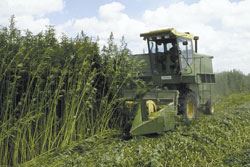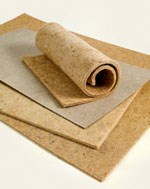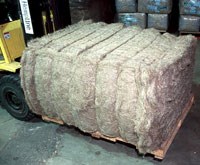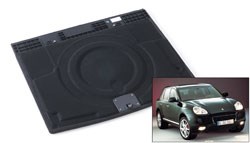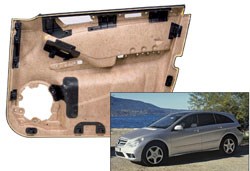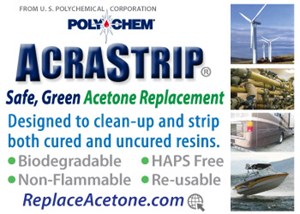Natural Fiber Composites Slowly Take Root
Lower-than-expected automotive growth reshapes outlook, encourages process development and exploration of new markets.
Driven by increasing environmental awareness, automakers in the 1990s made significant advancements in the development of natural fiber composites, with end-use primarily in automotive interiors. A number of vehicle models, first in Europe and then in North America, featured natural fiber-reinforced thermosets and thermoplastics in door panels, package trays, seat backs and trunk liners.
Promoted as low-cost and low-weight alternatives to fiberglass, these agricultural products, including flax, jute, hemp and kenaf, signaled the start of a "green" industry with enormous potential. A market study in 2000 projected growth rates exceeding 50 percent per annum through 2005.
Actual growth, according to natural fiber suppliers, has been much lower, although still respectable at 10 to 15 percent per year. Factors that have retarded growth include limitations in processing technologies and molded part performance as well as the recent economic lull that depressed auto sales and prompted a renewed focus by OEMs on purchased part price, which temporarily overshadowed potential weight savings, and concerns for recyclability and environmental stewardship.
There remains, however, a general consensus about the main advantages of natural fiber reinforcements, including lower weight, availability, ease of recycling, thermal and acoustic insulation, and carbon dioxide neutrality (when burned, the natural fibers reportedly give off no more carbon dioxide [CO2] than they consumed while growing). On average, the production of natural fiber suitable for composites is some 60 percent lower in energy consumption than the manufacture of glass fibers. These advantages in energy and environmental comparisons are becoming more quantifiable through the use of Life Cycle Analysis methodology being promoted by the U.S. Government.
Between 2000 and 2006, notable changes in the natural fiber landscape have occurred, including a shakeout in suppliers and the rise of specific fibers with improved properties, albeit at the expense of other natural fibers. Suppliers' efforts have been refocused on the development of new processes and on exterior applications, as well as markets beyond automotive.
EXPERIENCE REFINES FIBER SELECTION AND PERFORMANCE
The universe of "bio-fibers" is fairly broad. Included are very short wood fibers from both deciduous and coniferous sources, used as fillers in extruded plastic lumber and molding compounds. Also represented are straw from corn, wheat and rice crops, and various natural grasses. From a commercial standpoint, the most viable structural fibers come from purpose-grown textile plants and some fruit trees.
Such fibers can generally be classified into three types, says Prof. Lawrence Drzal, director of the Composite Materials and Structures Center at Michigan State University (East Lansing, Mich.). "Bast" fibers, such as flax, hemp, jute and kenaf, are noted for being fairly stiff when used as a composite reinforcement. Leaf fibers, including sisal, henequen, pineapple and banana, are noted for improving composite toughness with somewhat lower structural contribution. Finally, seed or fruit fibers — cotton, kapok and coir (from coconut husks) — demonstrate elastomeric type toughness, but are not structural. (Drzal, Prof. Amar Mohanty and Dr. Manju Misra co-authored a major reference book, Natural Fibers, Biopolymers and Their Biocomposites, published in 2005 by CRC Press.)
Among the purpose-grown plants, bast fibers represent the vast majority of natural fibers with potential for composites usage. Bast plant stems are characterized by long fibers surrounding a core of pulp or short fibers and covered with a protective bark layer. Separation of the useful fibers from the bark and core starts with a process called "retting," in which the cut stalks are soaked in water or left in the field in a humid environment for up to several weeks to degrade the natural binders. This makes the fiber bundles easier to process by mechanical means, or by hand, as is the case in many developing countries. As of the mid-1990s, flax and jute were the principal fibers used in biocomposites, but have been joined by higher strength industrial hemp and kenaf, at least in automotive applications.
Flax fibers are grown in two common forms. In North America, almost all flax is of the oil seed variety, predominantly grown in central Canada, but also cultivated in North Dakota and Minnesota. Its primary use is for linseed oil and food products. Attempts to commercialize the stalk fibers for composites were only marginally successful and have been largely abandoned. However, textile flax, a much taller plant and the source of commercial linen fiber used in clothing, now is the source for almost all flax-based natural fiber composites. It is grown widely in Russia, China and, to a lesser extent, Northern Ireland, Belgium and France.
The jute plant is native to southeast Asia, with India and Bangladesh responsible for more than 90 percent of worldwide production. Popular for the production of carpet backing, tote bags, sack cloth (burlap) and rope, jute is cut, retted, separated and cleaned in largely manual processes. Although jute has been partially replaced by other bast fibers in some of its earliest composite applications, it continues to be popular in interior automotive components.
The use of kenaf fiber as a reinforcement has grown substantially in the past decade. Resembling the hibiscus plant and related to cotton and okra, kenaf is grown widely in India and China, which together account for more than 75 percent of worldwide kenaf production. In the U.S., south Texas and eastern North Carolina supply relatively small amounts of kenaf.
An attractive feature of kenaf is that up to 40 percent of the stalk yields usable fiber, roughly twice that of jute, hemp and flax, which makes the fiber quite economical. Also, the plant can grow from seed to heights of 3.6m to 4.3m (12 ft to 14 ft) in five to six months. Asian kenaf is predominantly grown for the fiber, and soaking of the stalks during the retting process, combined with manual removal of the fibers, is believed to result in superior reinforcement quality. Comparatively, U.S. kenaf producers, including Kenaf Industries of South Texas (Raymondville, Texas) and Greene Natural Fibers (Snow Hill, N.C.), use field retting and mechanical separation. The kenaf core materials, which can be used as absorbents and animal bedding, have more ready markets. While both companies supply some fiber to the composites market, they also are pursuing other applications, such as extruded plastic fencing and decking, and furniture padding.
Industrial hemp is grown in more than 40 industrialized countries, although it is illegal to grow today in the U.S. Outlawed since the 1950s because it is a variety of the plant species cannabis sativa, industrial hemp contains less than one percent THC (delta-9-tetrahydrocannabinol), the active ingredient in the similar marijuana plant (which contains 5 to 20 percent THC). Hemp is grown in most countries in Europe, with Romania the largest producer. End uses include rope and twine, clothing and composite products.
Hemp is a robust plant, able to grow in less than perfect soils and across a broad range of climate zones. In northern climates, the planting season is March to May and harvesting occurs about four months later, when the hemp plants reach 6.5 ft to 13 ft (2m to 4m) in height. A growing market in North America for natural fiber composites encouraged Geof Kime, president of Hempline Inc. (Delaware, Ontario, Canada) to join efforts in the mid-1990s to convince Canadian legislators to permit the growing of industrial hemp. The company was founded in 1994, and produced the first bale of production fiber in 1998. Today, the company is the primary supplier of processed hemp fiber to the North American natural fiber composites market. Hempline's primary hemp fiber is shipped in purity levels from 85 to 99 percent and in staple lengths of up to 12.5 cm (5 inches), ready to be incorporated into composites.
AUTO INTERIORS STILL DOMINATE CONSUMPTION
The process of producing natural fiber reinforcements includes a drying step, where the natural plant moisture, including that gained during the retting process, must be removed. Over time, however, the fibers will absorb moisture from the air to return to some equilibrium point, which varies by fiber, but is typically in the range of 5 to 15 percent by weight. Encapsulation of the fiber in composite resins retards this pickup significantly, but the overall moisture pickup still exceeds that of fiberglass composites. Historically, this has precluded the use of natural fiber composites in high moisture environments such as exterior automotive body panels, although some breakthroughs and developments are occurring in that area.
Bast fiber composites are predominantly used in automotive interior panels, such as doors, pillar trim, trunk liners and package or rear-parcel trays. Early composites, replacing wood fiberboard, were a mixture of flax and sisal fibers in an epoxy matrix, first used on the Mercedes E-Class door panels in the early 1990s. The fibers are generally supplied in a needle-punched nonwoven mat format, and the simplest method involves placing the mat into the heated mold, pouring liquid resin on top, and pressing until cured. Most thermosetting resins, including polyester, epoxy, phenolic and urethanes, can serve as the matrix for natural fiber composites. Such low-viscosity resins provide excellent fiber wetting and adhesion, and the composites can be compression molded in more complex shapes than wood fiber-based materials.
An alternate method of combining the materials is preimpregnation of the mat prior to compression molding. A technology named NafPur Tec has been used in the production of door panels for the Mercedes E- and S-Class since the late 1990s, using Baypreg F sprayable polyurethane resin supplied by Bayer MaterialScience (Leverkusen, Germany). The nonwoven flax/sisal fiber mats are sprayed on each side, then stacked in a charge pattern before placement in the mold. The prepreg has a room temperature outlife of 30 to 45 minutes with molding occurring around 130°C (266°F) in as little as 60 seconds per cycle.
With increasing emphasis on recyclability, thermosets have been largely supplanted by thermoplastics in natural fiber interior components. Selection of the resin matrix is limited to polymers with lower melt-points — generally polypropylene and to a lesser extent, polyethylene. Thermal degradation of natural fibers begins as low as 120°C (250°F), with temperatures above 230°C (446°F) causing rapid decomposition of cellulose. Keys to minimizing this degradation include lower process temperatures and short thermal exposure. Both polypropylene and polyethylene have processable melt viscosities at or below this higher temperature.
For interior components made using thermoplastic matrices, the predominant format is still a needle-punched nonwoven mat. The resin is integrated via the use of thermoplastic fibers that are mixed with the natural fibers during a mat formation process that involves either a carding or an air-laying method. The needled fleece is a stable, easy to handle material with controlled levels of resin and fibers. Areal weights of the materials can be varied as needed to meet specific molded part thickness requirements, simply by changing the number of mat layers stacked prior to needling. Multilayer sandwich forms, incorporating barrier films or external plies of polypro-pylene/PET fiber blends (the PET fiber does not melt) can improve cosmetics and surface sealing. In-mold decoration technologies permit comolding of carpet, fabric or decorative film overlays with the natural fiber composite, generally without the need for adhesives, resulting in a single-step manufacturing process.
Production of the specific component involves cutting a blank, preheating it above the melt temperature of the polymer (nominally 200°C/392°F), transferring it to a room-temperature mold and pressing it into shape as the polymer cools, forming a rigid structure. Cycle times are typically under one minute per part. Molding pressures are low, in the range of 0.5 bar to 5 bar (7 psi to 75 psi), resulting in a part that is not 100 percent densified. High levels of densification reduce desired attributes of natural fiber composites, specifically ductility and absorption of energy and noise.
Jute is the principal fiber used in mat materials supplied to Tier 1 molders by FlexForm Technologies (Elkhart, Ind.), notes VP of sales Harry Hickey, citing advantages in product quality, availability and cost. The company also processes significant quantities of hemp and some kenaf. "Hemp is a great fiber, and can be grown virtually throughout North America," Hickey says. "However, supply is limited to Canadian sources due to regulations in the U.S. We would use more if additional domestic sources can be developed and they can supply a quality and cost-competitive product." FlexForm compositions are typically 50 percent (by weight) polypropylene and 50 percent natural fibers in various combinations. Rolls or sheets are commonly produced in widths up to 3.5m (11.5 ft) and areal weights from 450 g/m2 to 2,400 g/m2. Custom formulations also are possible. FlexForm products are used in a number of vehicles produced in North America, including the Chrysler Sebring, Mercedes M-Class SUV and R-Class Sport Tourer, and the Ford Freestyle and Expedition.
Quadrant Plastic Products AG (Lenzburg, Switzerland) is the world's largest supplier of glass mat thermoplastic (GMT) composites, and through its subsidiary Quadrant Natural Fiber Composites GmbH (Lambrecht, Germany) has established a strong position in natural fiber composites as well, explains Ronnie Törnqvist, market development manager for automotive interiors. Quadrant's Nafcoform material, available in areal weights of 300 g/m2 to 3,000 g/m2, is a blend of 50 percent polypropylene, and a 50 percent natural fiber blend consisting of equal quantities of kenaf, hemp and flax. Törnqvist explains that blending fibers provides a hedge against variability in any single fiber crop. "We have multiple suppliers of fiber, and as we are buying a natural material, any region can have abnormal patterns of sun, rain and soil conditions in a given year. We have found this ratio of fibers ensures relatively consistent performance in the finished part." The product is available unclad or with one of several surface fleeces or films (foils).
Among the vehicles using Quadrant's natural fiber composite are the Audi A8, Mitsubishi Space Star minivan, BMW 7-series, and an Iveco heavy truck line. The most structural applications of natural fiber composites, Törnqvist believes, are the load floors of the Volkswagen Touareg, Porsche Cayenne, and the just-introduced Audi Q7 sport utility vehicles. These parts are a sandwich of expanded polypropylene foam covered on each side with 1,400 g/m2 natural fiber/polypropylene composites, and topped with PET carpet. Weighing 3.5 kg (7.7 lb) and measuring 950 mm by 870 mm (37 inches by 34 inches), each load floor is produced in a single molding cycle. Törnqvist says Quadrant will open a facility in Guelph, Ontario, Canada in 2006 to manufacture its glass fiber-reinforced product SymaLITE and natural fiber-reinforced materials for the North American market.
NEW PROCESSES EXPAND APPLICATION WINDOW
One process that is gaining traction in long glass fiber-reinforced thermoplastics (LFRT) is the Direct Long Fiber Injection (D-LFT) process, in which raw polypropylene and glass reinforcements are melt compounded in a twin-screw extruder, producing a molten charge that is subsequently compression molded in a cold tool. Highly automated D-LFT systems produce parts in as little as 20 seconds (see CT August 2004, p. 46). Several of the companies involved in development of natural fiber applications have made D-LFT processing a key component in their commercialization efforts.
Composite Products Inc. (Winona, Minn.) produces compounding and molding systems for D-LFT, and has developed an extensive database on polypropylene reinforced with 40 percent kenaf, flax and natural fiber/glass hybrids. The company recently reported on efforts using corn hull particulate, from 0.5 mm to 5 mm (0.02 inches to 0.20) inches in length, as a substitute for talc and calcium carbonate filler, with similar strength properties and 15 to 20 percent lower density.
Using the D-LFT process, DaimlerChrysler AG (Stuttgart, Germany) introduced the first large-scale application (about 40 metric tonnes/88,000 lb per year) of natural fiber composites in an exterior application, starting with the 2005 Mercedes A-Class, two-door vehicle, The car's spare wheel pan cover is produced by Rieter Automotive Systems (Winterthur, Switzerland) using polypropylene resin and abaca fiber.
Abaca, a relative of the banana plant, is grown by small farmers in the Philippines. Known as "Manila hemp," abaca has long been a favorite fiber for marine ropes, although it is not related to the bast hemp plant described earlier. The fibers are stripped from the multiple 4m to 6m (12 ft to 20 ft) tall leaf stalks of the mature plants, cleaned, dried and twisted into fiber for spooling. The finished fiber is supplied to Rieter by Manila Cordage Co. (Makati City, The Philippines).
The compounding equipment was modified to ensure compatibility with the new reinforcement. The modified process now produces a part that is approximately 7 percent lighter and 5 percent less expensive than the fiberglass D-LFT component, notes Monica Prokopyshen, senior specialist in the Stationary Environmental and Energy group at DaimlerChrysler (Auburn Hills, Mich.). Because the composite is fully consolidated and the fibers are encapsulated with resin, moisture pickup is low enough to meet external part requirements.
The application is part of DaimlerChrysler's Global Sustainability Strategy and, in 2005, won the JEC Composites award in the category in the "Ground Transport" category. It also took top honors for environmental innovation at the recent Society of Plastics Engineers (SPE) Automotive Div. award banquet (see CT December 2005, p. 13). Prokopyshen explains the part is being extended to the entire A-Class and B-Class vehicle lines.
Efforts to replace fiberglass in sheet molding compound (SMC) with natural fibers also are underway. Ford Motor Co. (Dearborn, Mich.) reported some progress on this at the 2005 SPE Automotive Composites Conference, with research driven by the potential for weight savings and recyclability. Research on hemp mats and hemp twine (cut to one-inch lengths) combined with various polyester and vinyl ester resins shows promise, says Ford technical specialist Dan Houston, but notes that Ford is targeting current underhood applications of glass-reinforced SMC, such as heat shields, engine covers and noise shields, not class-A paintable surfaces. "We're encouraged, but there are still some hurdles, including reducing moisture pickup, and the inability, as of yet, to process the fibers in a traditional SMC format," he adds.
Meanwhile, researchers at the Composite Materials Research Group at the University of Mississippi (Oxford, Miss.) are exploring the pultrusion of natural fiber/fiberglass hybrid profiles, under contract to the U.S. Department of Agriculture. Early experiments using hemp yarns and hemp mats have yielded samples that are currently undergoing tests for mechanical performance. The research will look at the effects of surface modification and various fiber sources.
TeelGRT (Baraboo, Wis.) was started in 1996 to commercialize the compounding of natural fiber/thermoplastic composites. The company provides polypropylene and polyethylene materials with 25 and 50 percent (by weight) natural fillers, including wood flour and rice hulls, and reinforcements such as kenaf, hemp and cellulose fibers. TeelGRT does in-house compression molding and profile extrusion with the materials and sells the compounds for other processes, including injection molding. Targeted applications include not only transportation but construction and consumer markets as well.
CAUTIOUS OPTIMISM
Increasing competitive pressures, especially in the automotive industry, are clouding the outlook for natural fiber composites. Although end-of-life directives in Europe will force more recycling of vehicle components, they do not dictate the use of natural materials. Further market penetration, therefore, will occur only if the cost of natural fiber composites can be justified against competing technologies, such as the injection-molded unreinforced thermoplastics used today on many vehicles. FlexForm's Hickey believes the recent shift upward in petroleum costs favors natural fiber composites, as they are only 50 percent thermoplastic and therefore less sensitive to price increases. Terry Seagrave, the market channel manager for Bayer MaterialScience, and Quadrant's Törnqvist see increasing interest in natural fiber coming from Japanese OEMs, driven by the desire to obtain the improved properties without the use of fiberglass. Michigan State's Drzal and Ford's Houston envision opportunities in hybrids of glass and natural fibers, or the use of natural fiber as the core of a structural sandwich surrounded by glass fiber composite, particularly for exterior components subject to moisture exposure.
Drzal also notes there are U.S. government initiatives in place to encourage public/private sector collaboration in the development of bio-based materials, including natural fibers and novel resins. The conversion of bio-mass into bio-based industrial products, according to Drzal, offers outstanding potential for benefit to the national interest through improved strategic security and balance of payments, healthier rural economies, improved environmental quality, near-zero net greenhouse gas emissions, increased technology export and a sustainable resource supply. Two recent advances include the exploration of native, natural grasses as bast fiber substitutes and the creation of cellulosic "nanowhiskers" as fillers to improve properties.
What opportunities exist outside the automotive market? Törnqvist notes that requirements for flame, smoke and toxicity performance will exclude natural fiber materials from aircraft, rail and subway markets that could benefit from the lower weight potential. However, Drzal and Hempline's Kime are actively developing products to replace wood in construction and furniture. Sporting goods and consumer product markets also may offer opportunities. The fragmentation of these markets will pose a challenge, but the natural fiber community has already shown it can survive in a tough environment.
Related Content
Plant tour: Daher Shap’in TechCenter and composites production plant, Saint-Aignan-de-Grandlieu, France
Co-located R&D and production advance OOA thermosets, thermoplastics, welding, recycling and digital technologies for faster processing and certification of lighter, more sustainable composites.
Read MoreCirculinQ: Glass fiber, recycled plastic turn paving into climate solutions
Durable, modular paving system from recycled composite filters, collects, infiltrates stormwater to reduce flooding and recharge local aquifers.
Read MorePlant tour: Middle River Aerostructure Systems, Baltimore, Md., U.S.
The historic Martin Aircraft factory is advancing digitized automation for more sustainable production of composite aerostructures.
Read MoreMicrowave heating for more sustainable carbon fiber
Skeptics say it won’t work — Osaka-based Microwave Chemical Co. says it already has — and continues to advance its simulation-based technology to slash energy use and emissions in manufacturing.
Read MoreRead Next
Plant tour: A&P, Cincinnati, OH
A&P has made a name for itself as a braider, but the depth and breadth of its technical aptitude comes into sharp focus with a peek behind usually closed doors.
Read MoreCFRP planing head: 50% less mass, 1.5 times faster rotation
Novel, modular design minimizes weight for high-precision cutting tools with faster production speeds.
Read MoreVIDEO: High-rate composites production for aerospace
Westlake Epoxy’s process on display at CAMX 2024 reduces cycle time from hours to just 15 minutes.
Read More



